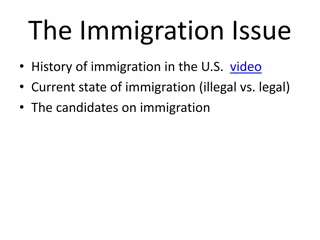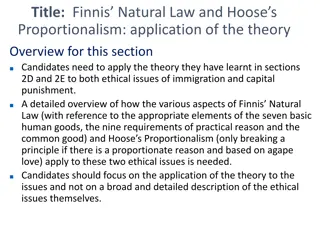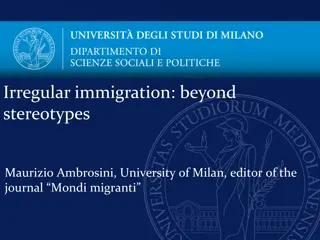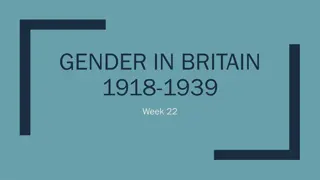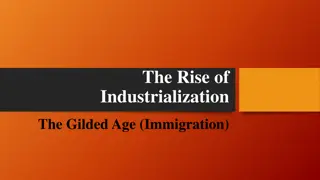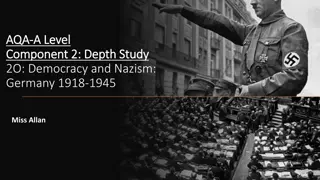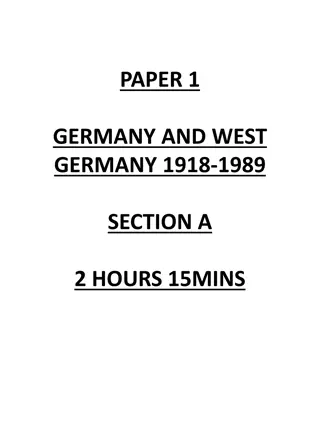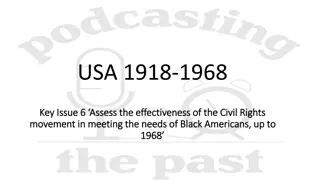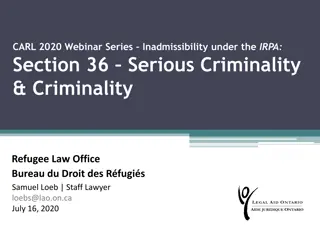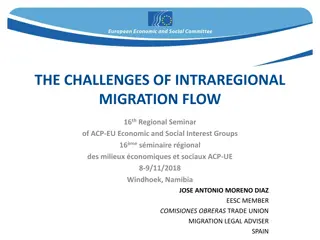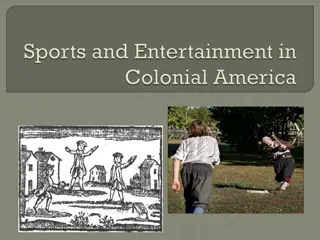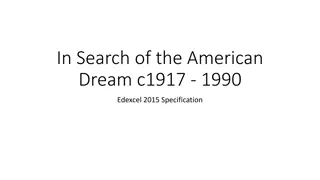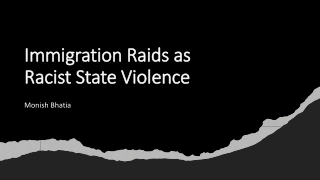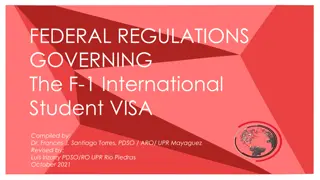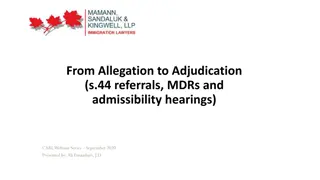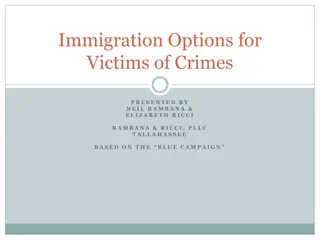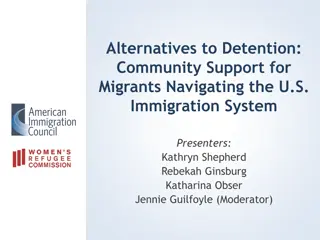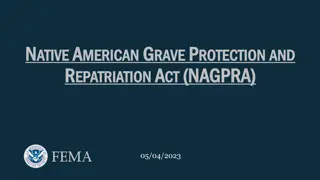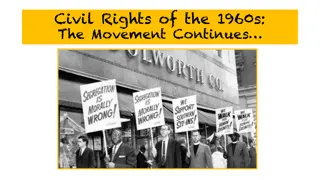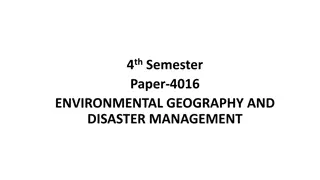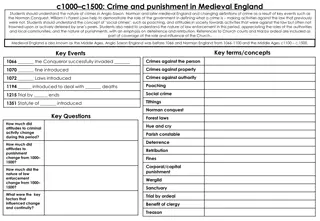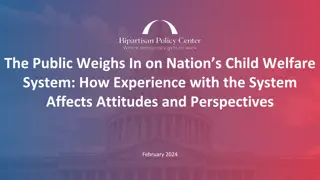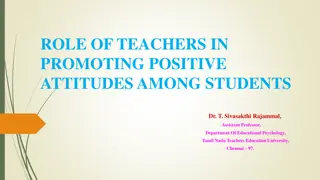Evolution of American Immigration Attitudes: 1918-1968
Attitudes towards immigration in the USA underwent significant shifts between 1918-1968 due to factors like isolationism, fear of revolution, prejudice, racism, social fears, and economic concerns. The influx of new immigrants from eastern and southern Europe challenged traditional American norms, leading to restrictive policies like the 1924 National Origins Act, which limited Eastern European immigration. Isolationist sentiments post-World War I further fueled anti-immigrant sentiment, reflecting a changing societal landscape.
Download Presentation

Please find below an Image/Link to download the presentation.
The content on the website is provided AS IS for your information and personal use only. It may not be sold, licensed, or shared on other websites without obtaining consent from the author. Download presentation by click this link. If you encounter any issues during the download, it is possible that the publisher has removed the file from their server.
E N D
Presentation Transcript
USA 1918-1968 Key Issue 1 Why did attitudes towards immigration change?
Factors 1. Isolationism 2. Fear of Revolution 3. Prejudice and Racism 4. Social Fears 5. Economic Fears
Context Give me your tired, your poor, Your huddled masses yearning to breathe free, The wretched refuse of your teeming shore. Send these the homeless, tempest tossed to me, I lift my lamp beside the golden door Emma Lazarus America s Motto: E Pluribus Unum = Out of Many, Comes One. Initially, immigrants came from northern Europe. These became known as OLD immigrants. Also known as WASPS, White Anglo- Saxon Protestants
Context By the 20th Century, there were more coming from eastern and southern Europe, who became known as NEW immigrants They were often poor, uneducated and didn t speak English. Many were Jewish/Catholic and looked un-American Between 1901 and 1920, the population of the USA grew by 39% to over 105 million. This was largely the result of increasing immigration Almost 80% of this new wave of immigrants came from southern and eastern Europe This was seen as a threat to the traditional WASP way of life However, due to the use of slaves on American plantations from the 16th century, there was also a significant Black population. Many Blacks chose to leave the south for better lives in the north after the American Civil War ended in 1865. Racial tensions were building
Isolationism Knowledge (BG) Isolationism: A policy of remaining apart from the affairs or interests of other groups, especially the political affairs of other countries (K1) WW1 was a catalyst in changing attitudes towards immigrants (K1) Having joined the war in 1917, the American army experienced the horrors or WW1, suffering heavy losses in battles such as the Meuse- Argonne offensive (K1) Following the end of the war in 1918, Americans regretted their involvement in a European war (K1) Many felt hostile towards anything foreign (K1) The Senate refused the ratify the Treaty of Versailles and subsequently refused to join the League of Nations
Isolationism Knowledge (K2) 1924 National Origins Act extended 1921 Act by reducing Eastern European immigrant quota to just 2% of the existing population of Eastern Europeans already in the U.S. per year according to 1890 census (K2)(e.g. if there were 100 Eastern Europeans in America in 1890, then only 2 people from Eastern Europe could immigrate to the U.S. in 1925) (K2) These Acts and the President s unwillingness to be involved in external affairs such as the League of Nations encouraged Americans to believe that immigration should also be reduced to help this policy
Isolationism Knowledge (K3) Life for foreign born Americans was not an easy one. They were accused of being loyal to their motherland. (K3) Germans, Austrians and Italians were suspected of being loyal to the Kaiser (K3) Irish immigrants were seen as anti-British and anti-America because they were Catholics (K3) Eastern Europeans were suspected of being communists or anarchists
Isolationism Analysis & Analysis Plus (A3) These isolationist ideas spread to a desire to curb immigration, avoid alien contamination and remove the threat towards American stock (A+2) These acts only limited Asian and Eastern European immigration, no limits were placed on WASP immigrants (A+2) Talk of life in Scotland, for example, was perfectly acceptable (A+2) Therefore, Isolationism did not impact on all immigrants (A3) This suspicion was a double standard as many Americans were of immigrant stock
Isolationism- Evaluation (EV2) Susan-Mary Grant: From an asylum for the oppressed, America, with this single act [National Origins Act], transformed itself into a glorified gated community (EV3) Hugh Brogan: there was a concern over eugenics that certain races weren t desirable enough to be American (EV3) M.A. Jones: The adoption of a quota system all but slammed the door on the southern and eastern Europeans who had formed the bulk of the arrivals in the pre-war and immediate post-war periods
Prejudice and Racism Knowledge (BG) Traditionally, immigrants to America had come from Western and Northern Europe. These immigrants were largely White Anglo-Saxon Protestants (Britain, Scandinavia, Germany). (K1) Throughout the 1880s, immigration numbers shifted to largely Southern and Eastern Europe- Italy, Turkey, Russia (K1) Dillingham Commission: Formed in 1907, discovered that since 1880s immigrants came from mainly eastern and southern Europe (K1) The Commission recommended literacy tests be introduced to weed out inferior immigrants (write a short passage in English)
Prejudice and Racism Knowledge (K2) The physical appearance of some immigrants frightened Americans. (K2) Many of the new arrivals were malnourished, and with deformities caused by vitamin deficiencies and poor diet. (K2) Immigrants sometimes continued to wear their own native clothing and were regarded as out of place on America s modern streets (K2) Cultures/ethnicities living together (K2) Melting Pot Theory: all the different immigrant backgrounds melted together to create one America. a melting of cultures and intermarriage of ethnicities cultural assimilation can also occur without intermarriage (K2) Salad Bowl theory: That all the different backgrounds came together BUT remained distinct (like vegetables in a salad) also called a cultural mosaic . Means immigrants still held on to some of their own cultures from home didn t fully assimilate
Prejudice and Racism Knowledge (K3) Californian laws against Asian immigrants were clearly racist in outlook - Alien Land Law of 1913 forbade aliens (immigrants)from owning any land in California. (K3) Most immigrants had left non-democratic societies and tended to view the law and Government as institutions that always catered to the powerful and therefore were not to be trusted. (K3) Many of these new immigrants were Catholic or Jewish and kept a strong sense of their religion in America
Prejudice and Racism Knowledge (K4) The KKK, having been set up to target Blacks, now included anti- Catholic, Jewish and Immigrant views (K4) They experienced a revival in their membership at the start of the c.20th (K4) The KKK championed the views of proper Americans (K4) This was known as NATIVISM (K4) People spoke out about the immigrant menace, wrote books and tried to find scientific proof of inferiority
Prejudice and Racism Analysis (A1) Southern and Eastern European immigrants- These new immigrants were seen as a threat to traditional, WASP ways of life (A2) Immigrants who continued to wear their native clothing and keep their traditions- This was seen as rejecting the idea of being an American Salad Bowl Theory (A3) Most immigrants left non-democratic societies and distrusted the gov. As a result, they were viewed with suspicion by Americans who saw this attitude as an attack on the American constitution (A3) Catholic or Jewish immigrants kept religious beliefs - These led to a belief that traditional Protestant ways of life would be lost (A4) America s experience during a war led to a surge of support for these nativist ideals
Prejudice and Racism Analysis Plus (A+) However, many Americans were of immigrant stock themselves and rejected these ideas (A+) They believed in the idea of American as Land of the Free (A+) Political parties saw the importance of gaining immigrant votes in elections and many were protected from harm
Prejudice and Racism - Evaluation (EV1) M.A. Jones: it was not the increased numbers, but the changing nature of the immigrants which led to calls for tighter controls and immigration restrictions in the early 20th century (EV1) Hugh Brogan on the Dillingham Commission: In this way official support was given to the ever-more-popular farrago of racist nonsense that was then masquerading as anthropology (EV4) Hugh Brogan: An upsurge of passionate nationalism the peoples [of the USA] clung to each other for reassurance and cemented their union with hatred, fear and contempt of foreigners.
Fear of Revolution- Knowledge (K1) Americans were fiercely proud of their capitalist and democratic ideals. Immigrants were associated with anarchy and insidious ideals. (K1) With the Russian Revolution in 1917, the government had been violently overthrown and a Communist one set up in its place (K1) Communist ideas are the exact opposite of what most Americans believe in free enterprise, competition and hatred of government interference (K1) Many communists were fiercely anti-war and were considered unpatriotic at a time America was involved in fighting the First World War (K1) Since many immigrants had left undemocratic countries, immigrants were seen as a threat to the American Constitution (K2) In January 1920, raids were conducted in 33 cities, arresting 6,000 radicals and detaining them without trial (K2) Many were beaten and forced to sign confessions. 600 were deported
Fear of Revolution- Analysis (A1) America feared that an influx of immigrants would led to the same events in America the Red Scare (A2) The raids highlighted the fear towards immigrants held by many WASPs and showed how they attempted to isolate themselves further
Fear of Revolution- Analysis Plus (A+1) HOWEVER: It is estimated that there were approximately 150,000 anarchists or communists in the USA in 1920 which represented only 0.1% of the overall population of the USA. (A+1) Palmer warned of a May Day demonstration and organised riot police, but the riot never happened (A+ 2) In reality, the Communist threat was greatly exaggerated, and the Palmer Raids led to the discovery of just three guns. (A+ 2) Most who were arrested had to be released due to lack of evidence.
Fear of Revolution- Evaluation (EV1) Alistair Cooke: The country was seized with the fear that the last great wave of immigrants had brought the revolutionary spirit with them (EV2) Susan-Mary Grant: For many in the U.S., the Palmer Raids went too far. Even after the Wall Street bomb, while shocked, these kinds of events no longer sent them running to check for reds under the bed . (EV2)Higham: Never before had anti-radical nativism stirred the public mind so profoundly.
Economic Fears- Knowledge (BG) Many immigrants were unskilled and looked for employment in America s booming industry in cities (K1) After the war, unemployment more than doubled from 5.2% to 11.7% by 1921 (K1) Employers could pay immigrant workers less because they were desperate for work and were willing to accept lower wages than WASP workers (K1) Many were employed as strike breakers and seen as stealing American jobs
Economic Fears- Analysis (A1) As a result of competition, there was increased anger towards the seemingly endless pool of cheap labouring immigrants as they were blamed for stealing jobs (A1) When wages were low and work was difficult to find, immigrants were used as scapegoats for unemployment and reduced availability of work
Economic Fears- Analysis Plus (A+) There was political opposition to some restrictions as big business relied on these immigrant workers (A+) Furthermore, conflict existed between immigrants' groups for work - Italians fought Irish for work in NYC
Social Fears- Knowledge (K1) Many of these new immigrants settled in American cities, rapidly increasing populations. Americans experienced overcrowding, housing shortages and rising rents as the demand for housing rose (K1) Immigrants had little money and low wages so could only afford the cheapest housing in the worst areas (K1) Whole families sometimes 10 or 12 people had only one room to live in (K1) They were damp, dark and filthy with no water supply, toilets or drains - rubbish and sewage was thrown into backcourts or streets (K2) Immigrants were also blamed for crime, drunkenness and disease with high rates of crimes in ghettos held as evidence (K2) Al Capone The Original Gangster
Social Fears- Knowledge (K2) Radical Italian immigrants accused of double murder in Massachusetts (K2) Both had alibis (inc. a work time-card) (K2) Many defence witnesses spoke in broken English and were manipulated by the prosecution (K2) Hat apparently belonging to Sacco found at the scene did not fit him (K2) Executed 1927 many believed it was due to their nationality and politics rather than hard evidence (K2) I am suffering because I am a radical. Indeed I am. I have suffered because I am Italian. Indeed, I am. Bartolomeo Vanzetti (K2) Nicolas Vanzetti was tried in Massachusetts twice, first for bank robbery and then for murder. In the first trial, Webster Thayer, who was the judge in both cases, told the jury: This man, although he may not have actually committed the crime.., is nevertheless morally culpable, because he is the enemy of our existing institutions. (K2) The trial of Nicola Sacco and Bartolomeo Vanzetti linked crime, immigration and un- American political ideas in the American mind
Social Fears- Analysis (A1) Immigrants tended to settle together (Little Italy, Chinatown), further increasing suspicion towards them in American minds. They were seen as eroding the integrity of a moral America (A1) Landlords could still put rents up due to the high competition which resulted in natives becoming hostile towards immigrants (A2) Statistics of soaring crime rates, drunkenness and riots in immigrant neighbourhoods was held up as proof of their undesirability and furthered calls for immigration limits (A2) Trial of Sacco and Batolomeo - Their trial furthered the idea of immigrants as criminals and undesirables
Social Fears- Analysis Plus (A+2) Charities, however, recognised that the true causes of crime were out with immigrant control (A+2) Most immigrant crimes were for petty offences petty theft, drunkenness, vagrancy (A+1&2) These crimes showed immigrants were having to resort to small crimes, owing to their appalling living conditions (A+1&2) Many unsavoury establishments (brothers, gambling dens) could only exist in less controlled immigrant neighbourhoods, drawing in undesirable people from wide areas


